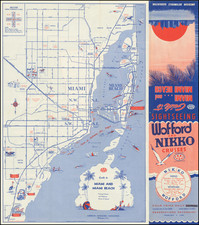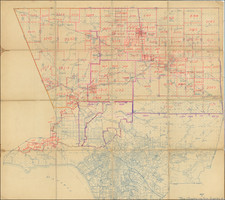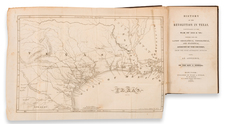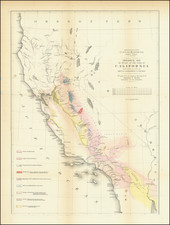First State of Sanson's Landmark Map of the Southern Parts of North America
Restored example of Nicolas Sanson's landmark regional map of North America, being the first large scale map to depict California and the Southwest and Sanson's first large format regional map of any portion of North America.
Sanson's map of the southern part of North America has the distinction of being the first large format regional map of North America prepared by this highly influential French mapmaker, whose revolutionary approach to the presentation of geographical knowledge on a printed map was responsible not only for the advancing French cartographic knowledge to the forefront of Europe's mapping of the New World, but perhaps even more importantly was responsible for profoundly altered the style and discipline associated with the graphic depiction of cartographic imagery, the essence of the map maker's art for the next 100 years. Before Sanson, the era begun by the Italian perspective artists of the 15th and 16th centuries and refined in the Low Countries by the skills of the fine master engravers of the Golden Age of Dutch Cartography objectivized maps not only for their content, but also as works of art. In Sanson's work, the embellishment of geographical imagery begins to give way to the science of geographical and spatial depiction. While it would be another 100 years before the mapmaker's art would truly be eclipsed by science, Sanson's work is without question and important point of inflection in this history, adding importance to this his first large format regional map of North America.
Sanson's map is the earliest to concentrate on Spanish territories from Florida to California and provided a prototype for other mapmakers over the next 50 years. Engraved by Jean Somer, it improves upon Sanson's Amerique Septentrionale in many ways. Amongst them is the first application of ERIE LAC to a recognizable lake. The depiction of California as an island was one of two most influential models (the other being the Briggs model), and was used as a model by many later cartographers.
First published separately, the map appeared in Sanson's atlases and later in composite atlases for the next 70 years. The Pierre Mariette in the title is the son of Nicolas Sanson's business partner of the same name, who provided the original investment for Sanson's business, but died in 1657. The Northwest Coastline is substantially revised from Sanson's map of North America. The Rio Grande, still mistakenly flowing southwest, includes many new Indian Names not present in the map of North America. The curious peninsula at the top of the Northwest Coast of the mainland (Agubela De Cato) is of unknown origin.
States of the map
There are four states of the map. The states can be identified as follows:
- State 1: Date on the map (1656) and the imprint "Chez Pierre Marriett, Rue S. Iaque...1656."
- State 2: Imprint reads: "Chez l'Autheu...1656."
- State 3: Adds an "r" to the word "Autheu," but retains the 1656 date.
- State 4: Dated 1679.
The popular misconception of California as an island can be found on European maps from the sixteenth through the eighteenth centuries. From its first portrayal on a printed map by Diego Gutiérrez, in 1562, California was shown as part of North America by mapmakers, including Gerardus Mercator and Abraham Ortelius. In the 1620s, however, it began to appear as an island in several sources. While most of these show the equivalent of the modern state of California separated from the continent, others, like a manuscript chart by Joao Teixeira Albernaz I (ca. 1632) now in the collection of the National Library of Brasil shows the entire western half of North Americas as an island.
The myth of California as an island was most likely the result of the travel account of Sebastian Vizcaino, who had been sent north up the shore of California in 1602. A Carmelite friar, Fray Antonio de la Ascensión, accompanied him. Ascension described the land as an island and around 1620 sketched maps to that effect. Normally, this information would have been reviewed and locked in the Spanish repository, the Casa de la Contratación. However, the manuscript maps were intercepted in the Atlantic by the Dutch, who took them to Amsterdam where they began to circulate. Ascensión also published descriptions of the insular geography in Juan Torquemada’s Monarquia Indiana (1613) (with the island details curtailed somewhat) and in his own Relación breve of ca. 1620.
The first known maps to show California as an island were on the title pages of Antonio de Herrera’s Descripción de las Indias Occidentales (1622) and Jacob le Maire's Spieghel Der Australische Navigatie (1622). Two early examples of larger maps are those by Abraham Goos (1624) and another by Henry Briggs, which was included in Samuel Purchas’ Hakluytus Posthumus or Purchas his Pilgrimes (1625). In addition to Briggs and Goos, prominent practitioners like Jan Jansson and Nicolas Sanson adopted the new island and the practice became commonplace. John Speed’s map (1626-7), based on Briggs’ work, is well known for being one of the first to depict an insular California.
The island of California became a fixture on mid- and late-seventeenth century maps. The island suggested possible links to the Northwest Passage, with rivers in the North American interior supposedly connecting to the sea between California and the mainland. Furthermore, Francis Drake had landed in northern California on his circumnavigation (1577-80) and an insular California suggested that Spanish power in the area could be questioned.
Not everyone was convinced, however. Father Eusebio Kino, after extensive travels in what is now California, Arizona, and northern Mexico concluded that the island was actually a peninsula and published a map refuting the claim (Paris, 1705). Another skeptic was Guillaume De L’Isle. In 1700, De L’Isle discussed “whether California is an Island or a part of the continent” with J. D. Cassini; the letter was published in 1715. After reviewing all the literature available to him in Paris, De L’Isle concluded that the evidence supporting an insular California was not trustworthy. He also cited more recent explorations by the Jesuits (including Kino) that disproved the island theory. Later, in his map of 1722 (Carte d’Amerique dressee pour l’usage du Roy), De L’Isle would abandon the island theory entirely.
Despite Kino’s and De L’Isle’s work, California as an island remained common on maps until the mid-eighteenth century. De L’Isle’s son-in-law, Philippe Buache, for example, remained an adherent of the island depiction for some time. Another believer was Herman Moll, who reported that California was unequivocally an island, for he had had sailors in his offices that claimed to have circumnavigated it. In the face of such skepticism, the King of Spain, Ferdinand VII, had to issue a decree in 1747 proclaiming California to be a peninsula connected to North America; the geographic chimera, no matter how appealing, was not to be suffered any longer, although a few final maps were printed with the lingering island.
Nicholas Sanson (1600-1667) is considered the father of French cartography in its golden age from the mid-seventeenth century to the mid-eighteenth. Over the course of his career he produced over 300 maps; they are known for their clean style and extensive research. Sanson was largely responsible for beginning the shift of cartographic production and excellence from Amsterdam to Paris in the later-seventeenth century.
Sanson was born in Abbeville in Picardy. He made his first map at age twenty, a wall map of ancient Gaul. Upon moving to Paris, he gained the attention of Cardinal Richelieu, who made an introduction of Sanson to King Louis XIII. This led to Sanson's tutoring of the king and the granting of the title ingenieur-geographe du roi.
His success can be chalked up to his geographic and research skills, but also to his partnership with Pierre Mariette. Early in his career, Sanson worked primarily with the publisher Melchior Tavernier. Mariette purchased Tavernier’s business in 1644. Sanson worked with Mariette until 1657, when the latter died. Mariette’s son, also Pierre, helped to publish the Cartes générales de toutes les parties du monde (1658), Sanson' atlas and the first French world atlas.











![[Charles Lindbergh - 1st Trans-Atlantic Flight - Printed on Linen]](https://storage.googleapis.com/raremaps/img/small/69233.jpg)
![[ First Gold Rush Edition! ] Colton's Map of the United States of America, The British Provinces, Mexico, The West Indies and Central America . . . 1849](https://storage.googleapis.com/raremaps/img/small/101951.jpg)

